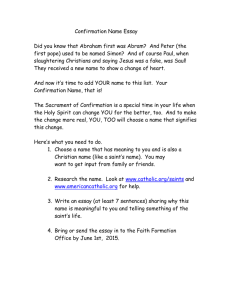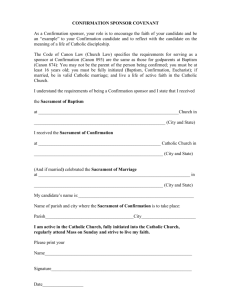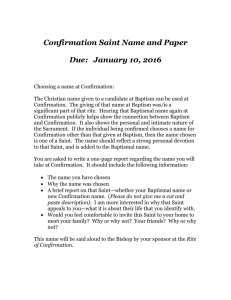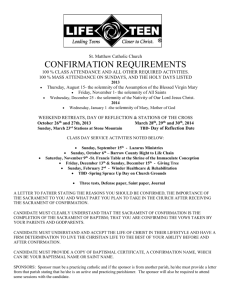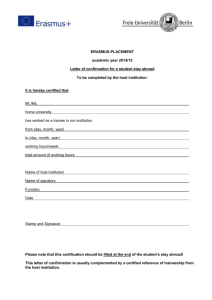Sacrament of Confirmation
advertisement
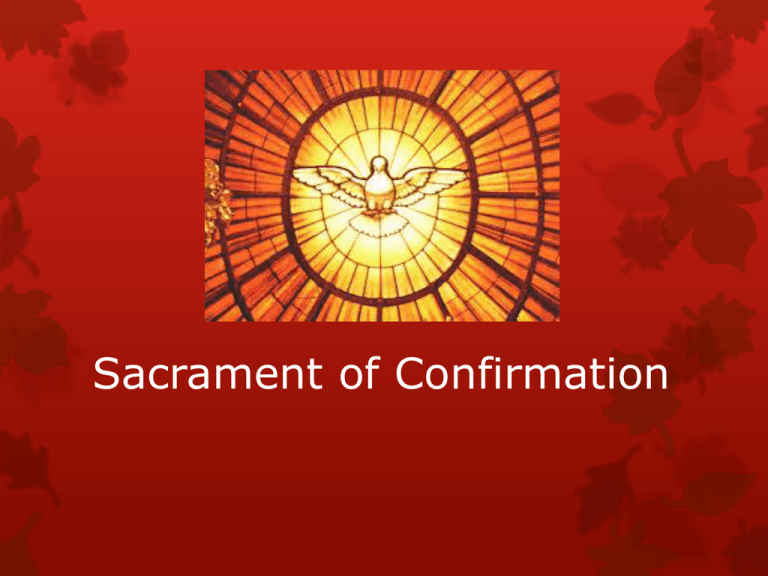
Sacrament of Confirmation Understanding the Sacrament of Confirmation At Baptism, we are reborn as sons and daughters of God, at Confirmation we strengthened by the gifts of the Holy Spirit to spread, defend, and practice the Catholic faith by words and deeds Jesus promised the outpouring of the Holy Spirit several times in His ministry: When facing persecution (Lk. 12:11-12) All must be “born again” (Jn. 3:8) Feast of the Tabernacles (Jn. 7:37-38) At the Last Supper, Jesus promised to send the Advocate (Jn. 16:7, 13) Origins of the Sacrament of Confirmation The laying on of hands symbolizes the giving of the Spirit as a sign of commissioning and divine blessing (example – Moses commissioning Joshua) Similarly, at Confirmation, we are given a divine blessing and the gifts of the Holy Spirit. The Holy Spirit resides and acts in us. Anointing with Oil Secular meaning (see pg. 99) Religious uses -- purpose for consecrating objects, (i.e. Ark of the Covenant), priests, and kings. Jesus is referred to as the “Christ” which means “Anointed One” Sacred Chrism – oil used at Confirmation; mixtures of olive oil and balsam (perfume). The balsam symbolizes the “odor” of Christianity our virtuous life and imitation of Christ can “attract” others to Christ. Two Traditions of the Sacrament Emerged Confirmation was originally part of the Sacrament of Baptism (referred by St. Cyprian as the “double sacrament”) In the Roman Church (West) Confirmation eventually became distinct from Baptism Because there were many parishes, the bishop had to come at a later date to administer Confirmation. In the Eastern Churches, the tradition of Baptism and Confirmation administered as a single sacrament continued. Teachings about Confirmation Baptism was originally followed by Confirmation (even if it was at a later date), then Holy Communion. With Pope Pius X’s encouragement for frequent communion and allowing children to receive communion, Holy Communion was given prior to Confirmation. Today’s Rite of Confirmation attempts to maintain the connection between Baptism and Confirmation: Adult converts celebrates all three Sacraments of Initiation at the Easter Vigil. The Church encourages the confirmand to use his/her baptismal name, have the same godparents Public renewal of baptismal promises at Confirmation ritual Celebrating the Sacrament of Confirmation The consecration of the Sacred Chrism takes place once a year, on or near Holy Thursday at the Chrism Mass. The bishop of the diocese blesses the oils of the sick, catechumen, and Chrism at the cathedral. Representatives from the various parishes each take a set of oil to be used the parish. The celebration of Confirmation takes place at a Mass presided by the bishop. What is the Form of the Sacrament of Confirmation? Matter? Form – “Be sealed with the Gift of the Holy Spirit” Matter – Sacred Chrism Who can be confirmed? Every baptized person who is not yet confirmed. In the Roman Church, Confirmation is delayed until the the person is “spiritually matured” There should be adequate preparation and instruction; along with a commitment to living out the Catholic faith. The Minister of the Sacrament As the successor to the Apostles, the bishop is the ordinary minister of Confirmation. Bishops possess the fullness of the Sacrament of Holy Orders. Priests can confirm during the Easter Vigil and in case of an emergency.
